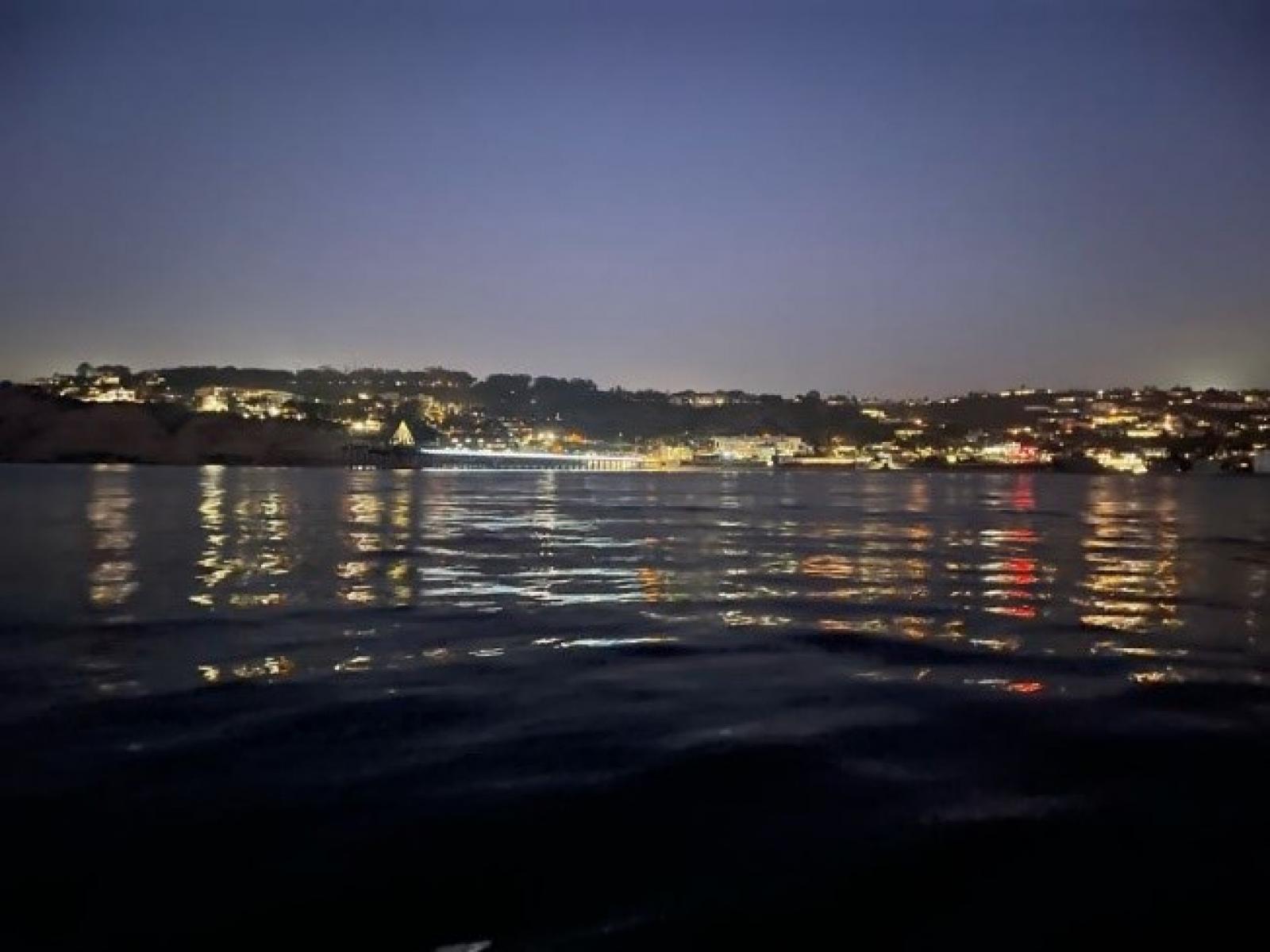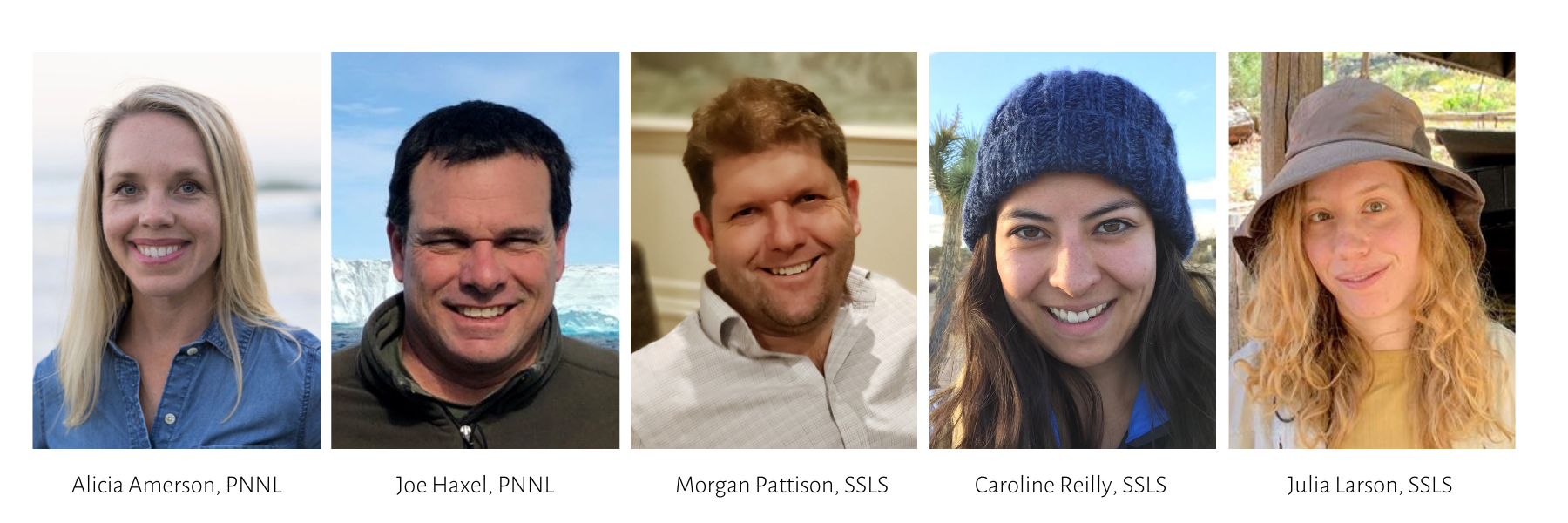Does Light Affect Underwater Wildlife?

A type of anthropogenic light known as skyglow as seen from a research boat.
(Photo by Alicia Amerson | Pacific Northwest National Laboratory)
Anthropogenic light is any light that is produced by humans. Animals rely on natural light for foraging, migration, sleeping, socializing, reproduction cues, and for entrainment of circadian rhythms. Many studies have shown both positive and negative changes in human physiological and behavioral responses to light and different types of light—take, for example, seasonal affective disorder as a response to decreases in light during winter months. Another example is insomnia caused by overexposure to light at night, especially from electronics’ screens. As with humans, unnatural light in the environment can cause stress to wildlife that depends on natural light and darkness cycles to survive in both terrestrial and underwater environments. In general, artificial light at night disrupts behavior and may cause stress to animals, thus negatively affecting the local ecology. Light may confuse or attract animals, potentially making it easier for predators to find and eat prey and harder for the prey to seek shelter. Additionally, like humans, light introduced during unnatural times can affect circadian rhythms and endocrine-system responses. The resulting physiological and behavioral changes may cause harm to individuals or populations depending on the severity and longevity of the disturbance.
Light or the lack of light is important to all species.
The Department of Energy Water Power Technologies Office's Triton Initiative is a project that works to reduce barriers to testing marine energy devices by researching and developing monitoring technologies and methods to understand potential environmental impacts. To date, Triton has studied several stressors of concern to marine energy regulators, including collision risk, changes in habitat, electromagnetic fields, and underwater noise. However, several possible stressors associated with marine energy devices still need to be explored to determine how to prevent disturbance to wildlife before the stressor becomes a regulatory concern. The "2020 OES-Environmental State of the Science Report" has not yet identified anthropogenic light disturbance as a stressor for the marine energy industry, although the U.S. government funds research on the topic to reduce impacts to wildlife in state and national parks and national marine sanctuaries. Triton is conducting research on the interactions of receptors and anthropogenic light associated with marine energy devices to address this need and provide recommendations to the industry on ways to avoid potential impacts through advanced lighting technology and best practices for lighting.
Triton's project manager and marine biologist, Alicia Amerson, and principal investigator and marine scientist Joe Haxel are working with lighting scientists Morgan Pattison, Caroline Reilly, and Julia Larson at Solid State Lighting Services, Inc. (SSLS), to conduct this anthropogenic light investigation. "This topic is new for marine energy discussions. Our project team contributes a lot of expertise to inform the industry and regulators on monitoring environmental effects. I believe that in working with our partners at SSLS, we will provide solutions to minimize the impact of light to wildlife in the marine environment," says Amerson.
Anthropogenic light and marine energy devices

Marine infrastructure, including marine energy devices, needs to implement lighting for maintenance and navigational safety purposes, such as preventing accidents related to human recreation and commercial activities. As development in the ocean expands with tourism, marine infrastructure, and blue economy applications, so does the presence of anthropogenic light. At this crossroad is a concern for natural behavioral patterns of wildlife and their need for dark habitats, yet the ecological effects of human-produced light in the marine environment have received limited attention.
An area of particular interest is the effects of marine-energy-related anthropogenic light on marine or coastal species, such as marine mammals and fish. Human-produced lighting in these otherwise naturally dark areas can also confuse seabirds or act as an attractant (Rodríguez et al., 2015). Lighting in a marine environment can include light that shines into the water from an above-water source or light that is underwater and illuminates infrastructure. By adequately understanding how animals' behavior changes when anthropogenic light is introduced into an underwater environment from both above and underwater sources, researchers and marine energy device developers can make informed decisions about lighting fixtures.
The goal is to minimize environmental impacts above- and underwater by strategically choosing lighting color, direction, intensity, luminescence, and other characteristics. While there is not currently a lot of research around the effects of anthropogenic light under water, lighting researchers do know environmental impacts can be related to the type of lighting. Namely, light-emitting diode lighting, better known as LED technology, can be directional, reduce unwanted light emission, and illuminate in colors that may be less disruptive to animals. LEDs can also be instantly dimmed or turned off, which can be more difficult with other lighting technologies. Consequently, LEDs have become an important technology used to minimize ecological impacts from lighting in terrestrial systems and could be an essential factor in reducing effects to marine life. LED lighting is also much more efficient than previous lighting technologies, reducing the battery and power generation requirements of off-grid installations.
Morgan Pattison, lighting scientist and chief executive officer of SSLS, explains, "the classic examples of lighting impacts on wildlife is with hatchling turtles that get disoriented by city lights and do not go toward the ocean from the beach where they are hatched" (learn more here). Using studies such as those that research the effects of light effects on turtles and that are conducted on avian species, in combination with an understanding of light dynamics, the research team can help inform decisions on how best to address anthropogenic light implications for the marine energy industry.
The research team
The SSLS team's expertise in LED lighting technologies and experience with wildlife interactions, combined with Triton's thought leadership and technical capabilities in environmental monitoring, creates a powerful research opportunity.
The Triton team brings abundant expertise in marine wildlife interactions with anthropogenic stressors and a passion for protecting marine ecosystems. Amerson has a background in anthropogenic impact research as a result of whale-watching. She has worked at the intersection of wildlife and human conflicts, collaborating with various researchers, government agencies, and communication experts to develop non-lethal management tools to aid in human coexistence with predators such as coyotes, bears, wolves, and sharks. Haxel's decades worth of experience researching the environmental effects of marine energy has focused chiefly on underwater noise; however, he has spent a lot of time researching how anthropogenic inputs alter marine ecosystems. He will help guide the technical aspects of the research toward the best outcomes for informing environmental effects.
For several years, Haxel hoped to work with Pattison at SSLS to explore anthropogenic light as a stressor associated with marine energy systems. "Light effects and underwater noise are similar stressors," says Haxel. He adds, "they are both physical stressors and have very similar characteristics and controls like frequency-spectral content, amplitude-wattage, and duration of exposure. The similarities between the work Morgan and I were doing provided a natural connection. When Alicia brought this project up in a strategic conversation, a light went off, and the connection to SSLS and the work they have been doing was clear."
Pattison has been involved with research and development projects on lighting technology for 15 years, working on projects for the Department of Energy Lighting Research and Development Program and the National Park Service. After many years of working on lighting stress mitigation projects, Pattison sees this project as an opportunity to connect the capabilities of advanced lighting technology with the safety and hazard detection needs of the marine energy industry. "I'm excited to connect animal understanding with improved lighting technology and practices enabled by LED technology to reduce the impacts of anthropogenic light on the ecosystem," shares Pattison.
SSLS lighting scientists Caroline Reilly and Julia Larson will also be supporting this research. Reilly will lead a literature review on the effects of anthropogenic light on marine ecosystems. Larson will review technical and legal lighting requirements for all marine energy installations to see where lighting technology can be improved to enable safe marine energy operation with minimal ecological side effects.
With this melding of expertise, the project hopes to develop recommendations for marine energy developers on lighting fixture implementation and increase knowledge around light characterization underwater and about specific attributes that may affect marine life. Haxel explains, "this is a new area of research for environmental effects around marine energy. With it, we hope to contribute recommendations for quickly leveraging existing advanced lighting technologies for best practices." He adds, "our partnership with SSLS provides expert knowledge and experience in the artificial lighting sector to get in front of this issue early and offer effective technical solutions."

What’s to come
Ultimately with this project, the Triton team aims to determine what lights will minimize impact to underwater ecosystems while still providing sufficient lighting for navigational safety and maintenance operations. The significant obstacle at hand is decoding the current literature on the topic. Because it is difficult to perform research with wild animals, many studies do not record all the lighting attributes we want to understand better. The literature review produced by this effort will identify what is already known about anthropogenic light impacts to marine ecosystems and determine where we can expand on the current knowledge through additional experiments. This review will guide subsequent project activities, including technology development, updated lighting guidance, and field research on lighting characterization and wildlife impacts at marine energy sites.
Because the marine energy industry is still in its testing phase, this research study comes at an opportune time for impact mitigation. "As part of the mission to reduce carbon dependency, we want to minimize and/or prevent any harmful disturbances to wildlife and the environment, "says Amerson. She continues to explain that by informing marine energy developers and regulators on this topic, we can proactively take steps to reduce anthropogenic light impacts for the future installation of marine energy devices. This project may be the beginning of an exciting, emerging field of research in the marine energy space, and it's all beginning with Triton and their partners at SSLS.
Note: Since this story was released, the research team has published a peer-reviewed paper reviewing anthropogenic light considerations for marine energy applications. Read the paper: Minimizing Ecological Impacts of Marine Energy Lighting

Story written by Cailene Gunn.
Published: December 10, 2021